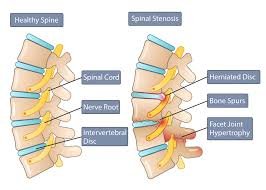
Causes of Lumbar Canal Stenosis
Lumbar canal stenosis can be caused by a variety of factors, including:
1. Aging: As we age, the spinal canal can narrow due to degenerative changes.
2. Herniated Discs: Herniated discs can bulge into the spinal canal, causing narrowing.
3. Bone Spurs: Bone spurs can form on the vertebrae, narrowing the spinal canal.
4. Spondylolisthesis: A condition where one vertebra slips out of place, narrowing the spinal canal.
5. Spinal Injuries: Trauma to the spine can cause narrowing of the spinal canal.
Symptoms of Lumbar Canal Stenosis
The symptoms of lumbar canal stenosis can vary depending on the severity of the condition. Common symptoms include:
- Pain: Pain in the lower back, legs, or buttocks.
- Numbness: Numbness or tingling in the legs or feet.
- Weakness: Weakness in the legs or feet.
- Claudication: Pain or discomfort in the legs or buttocks when walking or standing.
- Loss of Balance: Difficulty maintaining balance or walking.
Diagnosis of Lumbar Canal Stenosis
Diagnosing lumbar canal stenosis typically involves a combination of:
- Medical History: A thorough medical history to identify symptoms and potential causes.
- Physical Examination: A physical examination to assess muscle strength, reflexes, and sensation.
- Imaging Tests: Imaging tests such as X-rays, CT scans, or MRI scans to visualize the spinal canal.
- Electromyography (EMG): A test to assess muscle function and nerve damage.
Treatment Options for Lumbar Canal Stenosis
Treatment options for lumbar canal stenosis depend on the severity of the condition and may include:
- Conservative Management: Non-surgical treatments such as physical therapy, pain management, and lifestyle modifications.
- Medications: Medications such as pain relievers, muscle relaxants, and corticosteroids.
- Physical Therapy: A physical therapy program to improve mobility, strength, and flexibility.
- Surgery: Surgical intervention may be necessary to relieve pressure on the spinal cord and nerves.
Conservative Management of Lumbar Canal Stenosis
Conservative management of lumbar canal stenosis typically involves a combination of:
- Pain Management: Medications and other treatments to manage pain.
- Physical Therapy: A physical therapy program to improve mobility, strength, and flexibility.
- Lifestyle Modifications: Lifestyle changes such as weight loss, exercise, and stress management.
- Alternative Therapies: Alternative therapies such as acupuncture, massage, and chiropractic care.
Surgical Treatment of Lumbar Canal Stenosis
Surgical treatment of lumbar canal stenosis typically involves:
- Laminectomy: A surgical procedure to remove part of the vertebrae and relieve pressure on the spinal cord and nerves.
- Spinal Fusion: A surgical procedure to fuse two or more vertebrae together, stabilizing the spine.
Conclusion
Lumbar canal stenosis is a medical condition that can cause significant pain and discomfort. By understanding the causes, symptoms, diagnosis, and treatment options, patients can make informed decisions about their care. Whether conservative management or surgical intervention is necessary, a healthcare professional can help develop a treatment plan tailored to individual needs.
Book an Appointment
Are you suffering from chronic back pain, sciatica, herniated discs, or spinal deformities? Don’t let spine problems limit your life! Contact Us
